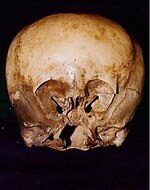Starchild skull
From Wikipedia, the free encyclopedia
The Starchild skull is an abnormal human skull which was found in Mexico. It has been claimed by paranormal enthusiasts to represent evidence of extraterrestrial contact.
Scientific testing has shown the skull is that of a male child who died approximately 900 years ago. His mother was human and, according to preliminary tests, his father too.[1] While some anomalies of the bone tissue were noted, no test result was inconsistent with the theory that the child was anything other than human.
Contents |
[edit] History
The starchild skull came into the possession of Lloyd Pye, a writer and lecturer in what he calls the field of alternative knowledge, in February 1999.[2] According to Pye, the skull was found around 1930 in a mine tunnel about 100 miles (160 km) southwest of Chihuahua, Chihuahua, buried alongside a normal human skeleton which was exposed and lying supine on the surface of the tunnel.[3]

The skull is abnormal in several aspects. A dentist determined, based on examination of the upper right maxilla found with the skull, that it was a child's skull, 4.5 to 5 years in age.[4] However, the volume of the interior of the starchild skull is 1600 cubic centimeters, which is 200 cm³ larger than the average adult's brain, and 400 cm³ larger than an adult of the same approximate size. The orbits are oval and shallow, with the optic nerve canal situated at the bottom of the orbit instead of at the back. There are no frontal sinuses.[3] The back of the skull is flattened, but not by artificial means. The skull consists of calcium hydroxyapatite, the normal material of mammalian bone.[5]
Carbon 14 dating was performed twice, the first on the normal human skull at the University of California at Riverside in 1999, and on the Starchild skull in 2004 at Beta Analytic in Miami, the largest radiocarbon dating laboratory in the world. Both independent tests gave a result of 900 years ± 40 years since death. [6] DNA testing in 1999 at BOLD, a forensic DNA lab in Vancouver, British Columbia found standard X and Y chromosomes in two samples taken from the skull, "conclusive evidence that the child was not only human (and male), but both of his parents must have been human as well, for each must have contributed one of the human sex chromosomes".[7] BOLD was unable to extract any DNA from the maxilla.[6] Further DNA testing at Trace Genetics, which unlike BOLD specializes in extracting DNA from ancient samples, in 2003 recovered mitochondrial DNA though it was not the child of the skull found with it. Its mother did belong to a known Native American haplogroup, haplogroup C. However, useful lengths of nuclear DNA or Y-chromosomal DNA for further testing have not yet been recovered. [8] Later testing in 2004 at the Royal Holloway college of the University of London revealed unexplained "fibers" in the bone of the skull and a reddish residue in the cancellous bone, neither of which are known or recorded to exist prior to the discovery.[9]
Explanations from the skull's unusual features include the use of cradle boarding on a hydrocephalic child,[10] brachycephaly, Crouzon syndrome,[11], congenital hydrocephalus, and progeria.[citation needed]
[edit] Paranormal interest
Despite criticism from established science, the skull has gathered great interest within the study of UFOs and extraterrestrial life. Some contend that it is the skull of an alien, or a human/alien hybrid, based on the shape of the skull bearing similarities to the common representation of aliens as "Greys".[12]
[edit] References
- ^ Novella, Steven MD "The Starchild Project" The New England Skeptical Society [1]
- ^ Pye, Lloyd. "TERRIBLE TWO'S : Summary of the first Two Years". Starchild Project. http://www.starchildproject.com/BackgroundTT.html. Retrieved on 2006-10-01.
- ^ a b McCoy, Max (November 1999). "Star Child". Fortean Times (127): 42–45.
- ^ Brown, Matthew. "A Report on Maxilla and Dental X-Rays". Starchild Project. http://www.starchildproject.com/Reports_Brown.html. Retrieved on 2006-10-01.
- ^ Robinson, Ted J.. "A Preliminary Analysis of a Highly Unusual Human-Like Skull". Starchild Project. http://www.starchildproject.com/Reports_Robinson.html. Retrieved on 2006-10-01.
- ^ a b Pye, Lloyd. "A Forensic DNA Analysis of two Unusual Skulls of Uncertain Origin". Starchild Project. http://www.starchildproject.com/SweetDNAReport.html. Retrieved on 2007-12-29.
- ^ Novella, Steven MD "The Starchild Project" The New England Skeptical Society [2]
- ^ Pye, Lloyd. "Early DNA Testing". Starchild Project. http://www.starchildproject.com/Reports_Sweet.html. Retrieved on 2006-10-01.
- ^ "Alien Skull Mystery Continues". WUSA9. October 23, 2004. http://www.wusatv9.com/news/news_article.aspx?storyid=34268. Retrieved on 2006-10-01.
- ^ Phoenix, Jack (Early 2005 (special)). "Unconvention 2004". Fortean Times (191): 28–30.
- ^ Chow, Adelina (2006). "The Mystery of the Starchild Skull". World-Mysteries.com. http://www.world-mysteries.com/sar_6achow.htm. Retrieved on 2006-10-01.
- ^ "WORLD EXCLUSIVE DNA PHOTOGRAPHS". http://www.starchildproject.com/DNA.html. Retrieved on 2007-04-11.
[edit] See also
[edit] External links
- Starchild Project Website (advocacy of alien theory)
- The Starchild Project - Critical overview by Steven Novella
- The Mystery of the Starchild Skull (critical)
|
||||||||||


